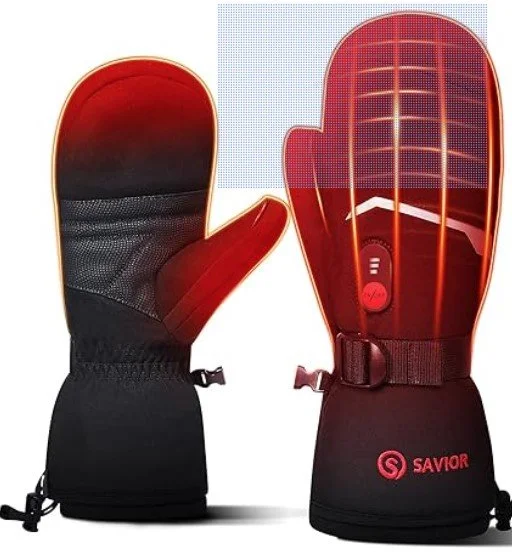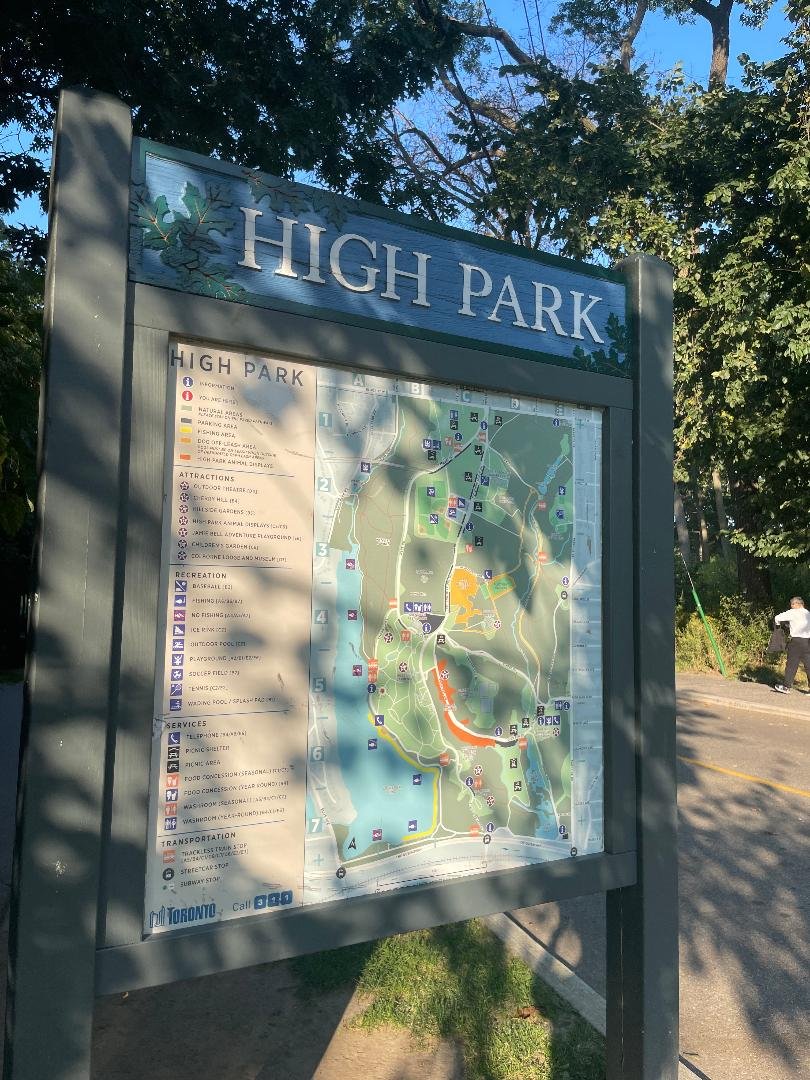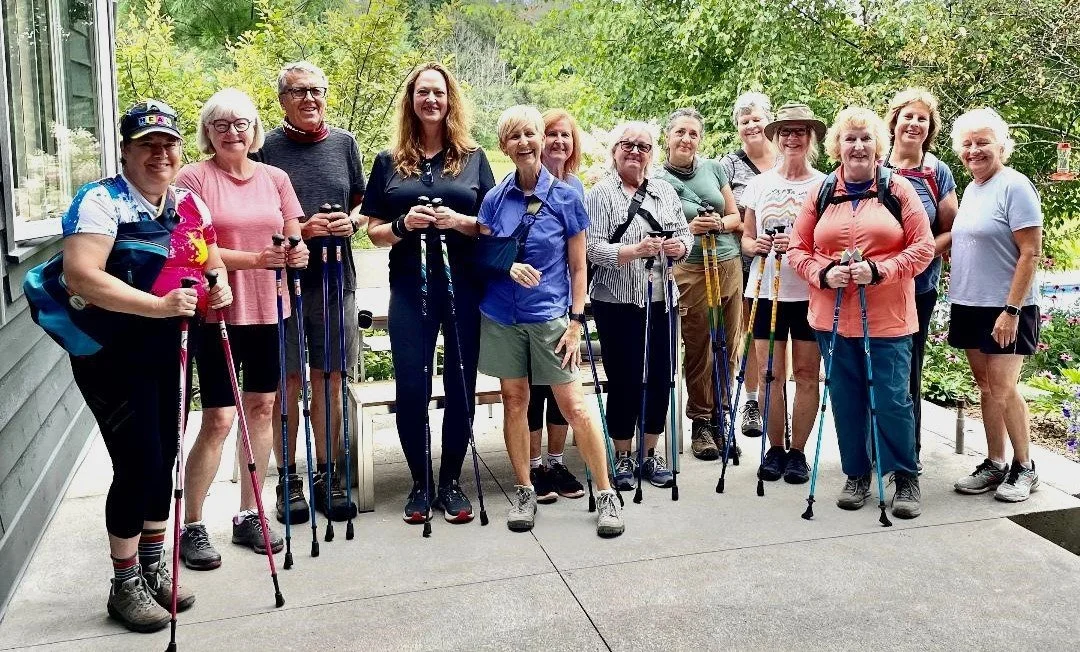Test Drive #6 — Blister Bandages
Manage, or even prevent, blisters with these amazing bandages.
Band-Aid blister bandages
If you’re a Nordic walker or hiker like me, you know the worst thing that can happen on a walk is the dreaded blister. Whether it’s due to a new pair of shoes or socks, extra-sweaty feet, or an unexpectedly long route, blisters can ruin an otherwise beautiful day outdoors.
Even if you’re lucky enough to have a basic first aid kit with you, sticking a standard bandage over a blister just doesn’t do the trick. They shift, rub off, or sweat off within minutes. And even if they manage to stay on, they don’t provide enough protection to stop the pain.
A few years ago a Nordic walking colleague told me about “blister bandages.” I’ve found that Life Brand and Band-Aid brand are both exellent options.. (If heel blisters are your issue, go for Life Brand, which are bigger than the Band-Aid version.)
Why I Recommend Them:
Seal, protect and promote healing
The bandage creates a waterproof, dirt-proof, germ-proof barrier. You don’t need any ointment—just apply the bandage directly on the blister and leave it. Hydrocolloid material absorbs moisture from the blister, creating a moist wound environment. This absorbed moisture combines with the hydrocolloid to form a gel-like substance, which appears as a white bubble on the surface of the bandage.Stay put
They don’t budge in the shower, during a long walk, or even while washing dishes (they’re good for small cuts on your fingers). They naturally fall off once your blister is healed.Can prevent blisters
If you know you have a trouble spot on your foot, apply one before your walk to prevent friction and irritation.Variety of sizes
There are variety packs and packs just for heel blisters. I usually get the larger bandages specifically for heel protection.
The only downside? The price—currently about $7.99 for a box of 10 in Toronto (at Walmart and Shoppers Drugmart).. But when you’re halfway through a long hike or midway through a week of walking, I think they’re worth every penny.
50 Ways to Find Happiness in Toronto
The Toronto Star features my two all-time favourite places for Nordic walking in Toronto!
Mount Pleasant Cemetery archway by Garden of Remembrance. (Photo credit: Paul Joseph)
“Take a stroll through Mount Pleasant Cemetery, an oft-overlooked gem of parkland, trails and historic grave sites in the middle of the city. Coming across the monuments of prominent Canadians, such as former prime minister William Lyon Mackenzie King, department store magnate Timothy Eaton and pianist Glenn Gould, is a reminder of the illustrious history of our great city.”
Kenyon Wallace
journalist
Stunning spring cherry blossoms in High Park.
“Any time that I take a walk in High Park, I wonder why I don’t do it more often. Going there is such an easy way to escape from the busy city life to nature. From watching happy dogs playing and chasing each other to watching the variety of birds at different seasons, it is a place that fills me with joy.”
Babak Lakghomi
advice columnist
Source: January 4, 2025, Toronto Star article, “50 Ways to Find Happiness in Toronto.”
The Walking/Talking Combo Can Boost your Brain Health
“Dual-task walking” can help slow age-related cognitive decline.
When I’m teaching a Nordic walking class, there’s always plenty of good-natured chatter. That’s part of the fun— catching up with friends while getting a great workout. Socializing makes the time fly by.
But as you chat, of course, don’t let your good Nordic walking technique slip.
Proper Nordic walking technique is key to reaping all the physical benefits. If your form is off, you won’t get the full workout effect, and you risk tripping over your poles or someone else’s.
That said, research is now telling us that the walking/talking combination offers more than just physical and social benefits. In fact, studies show that “dual-task walking”—the act of walking while engaging in conversation—can help slow age-related cognitive decline.
As one researcher explains, “We suggest that the dual-task combination of multisensory cognitive stimulation and multimodal moderate physical exercise training, twice a week, may be adopted as an effective program to reduce the progression of age-related cognitive decline and improve physical fitness and quality of life in healthy older adults.”
One important reminder: Enjoy your walking and talking, but always stay aware of your surroundings, especially cars, cyclists, and other pedestrians.
Test Drive #5: Savior Heated Mittens
If you struggle with cold hands while Nordic walking, these mittens might be just the solution you‘ve been looking for.
Do you, like me, struggle to keep your hands warm in the freezing weather—especially when you’re Nordic walking?
Finding the perfect mitts or glove-mitten combination has always been a challenge for me. I find it frustrating because there’s no way to test new mitts or gloves until you’re out in the cold. Over the years, I’ve found that many mitts and gloves don’t live up to their marketing—leaving my hands cold once again.
Disposable hand warmers have never worked well for me. I’m not a fan of how uneven the heat is. Plus they get too hot, and they aren’t recyclable.
My first pair of heated gloves were from Canadian Tire and were quite good.
But they had a few flaws:
They were gloves not mitts. The battery-operated heating wires were only in the palm, not the fingers where I needed them most.
They came in men's sizes only, making them bulky for my smaller hands.
They used AA batteries, which were a bit heavy and inconvenient.
My hands eventually got sweaty, forcing me to turn the heat off and on a few times on long walks.
My new favourite heated mittens
I recently discovered Savior heated mittens online and upgraded to this higher quality mitten. Here’s what I think makes them great:
Mitts not gloves: While Savior also sells gloves, I find mitts much warmer.
Effective heating: Heating wires run along the back and palm of the hand and also in the thumb pocket.
Customizable comfort: Three temperature settings help prevent overheating and sweaty hands. And, once turned on, the temperature automatically gradually turns down.
Rechargeable batteries: No more disposable batteries! The company claims that a single charge lasts up to six hours.
Nordic walking friendly: The bulky part of the mitten is on the back and palm, not along the little-finger edge, so I can still easily feel the ledges of my pole handles.
Are they worth it?
At $90.00+, these heated mittens are pricier than standard cold-weather gloves and mittens, but I see them as a long-term investment. With their durability, rechargeable design, and consistent warmth, I’m hoping they’ll keep my fingers happy for many winters to come.
If you struggle with cold hands while Nordic walking, these mittens might be just the solution you‘ve been looking for!
Note: As with all of my Test Drive blog posts, I’m sharing simply because I love the product—no sponsorships or renumeration involved!
Test Drive #4: Mark's Wind River Hyper-Dri Lined Pants
Looking for a solution to staying warm on these cold and snowy winter days? Check out the latest addition to my winter wardrobe.
Looking for a solution to staying warm in the biting cold ? Check out the latest addition to my winter wardrobe.
Mark’s WindRiver Hyper-Dri Lined Pants
One of the most common questions I get right before a Nordic walking class—especially on a cold, blustery winter day—is, “What are you wearing today?”
My answer? A full breakdown of my layers, including brands and where I found them.
I’ve lately been talking up my new flannel-lined Wind River Hyper-Dri Lined Pants purchased at Marks.
After wearing my previous flannel-lined pants (also from Mark’s) for many years, I decided it was time for an upgrade. Their newest version, the Wind River Hyper-Dri Lined Pants, has definitely met my expectations
Designed for cold-weather activities, these cozy pants feature a smooth wind- and water-resistant exterior and a soft, brushed flannel interior lining for added comfort and warmth.
Non-bulky layers are key
Layering is the tried-and-true method for staying warm during winter. However, I find that traditional layering options, like longjohns under pants or wind/rain pants overtop of pants, are too bulky and can hinder mobility.
For activities like Nordic walking, unrestricted arm and leg movement is essential. Lined pants offer comfort, warmth and mobility in one streamlined unit.
A step up from the original design
Here are several upgrades that I appreciate in this latest version of Mark’s lined pants::
Improved waistband:
The waistband now features both a button closure and Velcro tab, ensuring it lies flat. This small change eliminates the rolling over I experienced with my older pair.More and better pockets:
The new design includes several flat-lying zippered pockets, a big improvement over the basic two non-zippered slash pockets on the original pants.Soft, stretchy fabric:
The lining is softer and almost fleecy, providing extra coziness. And the outer layer of the pants is now more stretchy, allowing for greater ease of movement.
Fit and sizing tip
I initially tried on my regular size, which fit nicely. However, I chose to size up, as the larger size offered more room in the thighs while still fitting well at the waist.
Get-dressed-faster tip
When getting dressed, put your pants on first, followed by your socks. If you put your socks on first, they will stick to the fuzzy lining making getting dressed more time consuming than it need be.
Many options in this category
I can find no downside to these pants! They are priced at $89.99, which seems reasonable to me given the quality and thoughtful design.
But if these particular pants don’t suit your style or budget, there are plenty of other options to explore. Retailers like Eddie Bauer, Lululemon, Columbia, Mountain Warehouse and Amazon all offer similar styles.
Note: As with all of my Test Drive blog posts, I’m sharing simply because I love this product—no sponsorships or renumeration involved!
Simple Habits That Build a Strong Body & Mind
Sometimes the best life advice fits in just a few lines
The more you walk the better you feel.
The more you lift the more muscle you build.
The more you get outside the happier you are.
The more hard things you do the easier your life becomes.
Walk. Lift. Get outside. Do hard things.
This is the way.
Source: @mindset.therapy
Happy Nordic walkers in High Park, Toronto
The Best Places to Nordic Walk in Toronto: High Park & Mount Pleasant Cemetery
Looking for the perfect locations to enjoy Nordic walking in Toronto?
Looking for the perfect locations to enjoy Nordic walking in Toronto?
Let me introduce you to two of the city’s best spots: High Park and Mount Pleasant Cemetery.
1. High Park – A Nordic Walker’s Dream
High Park, located in Toronto’s west end, is famous for its variety of trails making it a fantastic destination for Nordic walking enthusiasts.
If you’re looking for a challenge, this park has some steep hills and staircases that will get your heart pumping. The wooded paths allow you to experience nature at its finest – towering forest, lush greenery, beautiful flowerbeds, and the sounds of singing birds.
One of the best parts of Nordic walking here is the peaceful atmosphere. Despite being a popular park, there is room for everyone and very little car traffic. On weekends the park is closed to cars making it a walker’s dream location.
2. Mount Pleasant Cemetery – Serene and Scenic
If you’re after a walking experience that is even more serene, Mount Pleasant Cemetery, in midtown Toronto, is the ideal choice.
The sprawling 200-acre cemetery offers smooth, flat roads, making it a perfect option for Nordic walkers of all skill levels, especially beginners who aren’t ready to tackle hills and stairs.
The beauty of Mount Pleasant lies in its peaceful environment – it is quiet, almost car-free, and dotted with beautiful headstones, sculptures, flower gardens, and fountains. The rich history and thoughtful design of the cemetery makes walking workouts both relaxing and energizing.
******
While you can explore both High Park and Mount Pleasant Cemetery without poles, taking your Nordic walking poles adds multiple benefits.
With poles you will:
activate more muscles
burn more calories
enjoy a full-body workout.
Plus, research shows that people with Nordic walking training and who walk with a group are more likely to stick to their fitness goals and to exercise more frequently.
If Nordic walking sounds intriguing, check here for information on my 75-minute one-time Quick-Start Clinics and seasonal 12-week sessions. Where? You guessed it, High Park and Mount Pleasant Cemetery!
The Benefits of Engaging Your Brain During a Workout
Boost your brain health with exercise.
"Exercise seems to boost brain health in different ways, both immediately and over the long term......
It triggers the production of brain-derived neurotrophic factor, or BDNF, which spurs the growth of new neurons in the hippocampus, a region of the brain associated with learning and memory.
That's important because the hippocampus is shrinking by about half a percent a year by the age of 55, and that shrinkage is associated with declines in learning, memory and spatial thinking.
Scientists now believe that lactate "functions as both a chemical signal and as a fuel for cells throughout the body, including brain cells" rather than a "poison which made your muscles burn during exercise".
"The lactate you produce during hard exercise fuels your brain cells and also sends a signal to activate BDNF.
The BDNF, in turn, facilitates "long-term potentiation" which essentially means that the connections between any nerves that happen to be firing will be strengthened.That implies that what you do with your brain during exercise matters because those are the neural pathways that will be reinforced"
Alex Hutchinson, The Globe and Mail, July 29, 2024
Have You Checked Your Nordic Walking Pole Boot Tips Lately?
Improve your Nordic walking technique to extend the life of your boot tips.
If you haven’t checked the boot tips of your Nordic walking poles recently, now is a great time—especially if you’re new to the activity.
Uneven wear on the boot tips, one smooth and one still with tread, often signals a technique issue related to your dominant and non-dominant arms.
The dominant arm typically masters the Nordic walking motion more quickly, lifting the boot tip slightly off the ground with each swing—an essential part of proper form. However, the weaker, non-dominant arm may drag the boot tip forward instead, which leads to faster wear and tear.
The fix is simple:
• Lift with your fingers: Use a subtle lifting action with your pinky and ring fingers to raise the boot tip just slightly off the ground. as your pole swings forward.
• Check your swing height: Ensure the pole handle of your non-dominant arm swings up to the very same height as that of your dominant—right to a “handshake position.”
If the handle swing is too low, the boot tip will slip back along the ground instead of planting. To correct this, swing the handle on your non-dominant side an inch or two higher (to a full handshake height) .
Avoid bending your elbow or altering your overall technique. Focus on the small adjustments of lifting slightly with the fingers and swinging both handles to a handshake height..
Pro Tip
Pay attention to the sounds your boot tips make. A consistent, quiet “thud” from both indicates proper form. If one boot tip drags or slips, the difference in sound will be noticeable.
Another Beautiful Experience at Sea, Sand & Soul 2024
Amazing women, spectacular weather, and the best venue ever!
I’m just back from our third annual Sea, Sand & Soul fitness retreat to beautiful Prince Edward Island!
It was yet another magical experience with some of the lovliest and most interesting women ever.
Several of my Toronto Nordic walkers attended (some for the third time!) while many others arrived from Ottawa, home of my fitness colleague, co-organizer, and friend Nina LePage. Yet others came from from Quebec, New Brunswick, and smaller cities and towns in between.
Each morning began for some of us with a brisk dip in the ocean—what better way to start the day? Afterward, there was yoga and stretching indoors, on the sandy beach, or on the grass outside Cottage 6. The peaceful backdrop of the brilliantly blue sky and the rustling long grasses made it easy to find our flow and connect with nature.
On several days, we Nordic walked along the ocean, taking in the beauty of PEI’s coastline.
When rain came, our driver, George, whisked us away to some of the nearby charming villages. In North Rustico, a spontaneous shopping spree happened at The Wool Sweater Company, where eight beautiful rain slickers were purchased within minutes of arriving, along with with cozy wool socks and sweaters.
We bought plenty of sweets for friends, family, and of course, for ourselves, at Jane and Sue’s Chocolates in Stanley Bridge.
We enjoyed a memorable tour of Charlottetown with our regular guide, Josh, who shared interesting insights into the city’s history, architecutre and current events.
On one of our sunniest and windiest days, we cycled to Old Trachedie Harbour, about an hour away, for lunch. For some, it was an easy ride, but for others it was a great challenge.and memorable achievement.
On our final day, Ethain Arsenault, an interpretation officer from Parks Canada, walked us along the island’s famous red dunes (a UNESCO World Heritage Site). His wealth of knowledge captivated us as he described the devastation that 2022’s Hurrican Fiona caused to the dunes and national park.
We also learned about the plant life and the piping plother that make PEI such a unique natural treasure. It was an eye-opening and beautiful way to connect more deeply with the island.
Another highlight of our retreat was a talk by Robbie Shaw, the fourth-generation owner of Shaw’s Hotel. Robbie shared the rich history of the hotel, which has been in his family for over a century. His stories, including those about the challenges of stepping up to run the business at just age 22, were fascinating and inspiring. Hearing how he has continued the hotel's legacy while adapting to modern times made us all appreciate the unique charm of Shaw’s even more.
The trip woudn’t have been the same at any other venue. We felt so well taken care of by the incredible team at Shaw’s—Jeannie, Easton, Barb, Kennedy, and Robbie—who ensured that every detail was perfect throughout the week.
On our last evening we gathered for a traditional P.E.I. lobster supper (with options of beef tenderloin and a vegetarian dish, for those who didn’t eat lobster).
As we wrapped up our six days together, surrounded by nature, wonderful company, and the unique energy of P.E.I., I think we all felt a deep sense of gratitude.
From the ocean swims and Nina’s amazing yoga sessions, to exploring the island’s treasures and indulging in local flavours, this retreat was an incredible reminder for me of the importance of balance—between body, mind, and soul.
Nina and I are still shaking PEI sand out of our clothes and readjusting to city life. But we’ll shortly take a longer look at the group’s feedback and begin planning and organizing our fourth Sea, Sand & Soul.
We assume that next year there will be a little more of this, a little less of that, and of course some new and exciting additions to the schedule of activities.
We can't wait to see old and new faces at next year's retreat—until then, keep your hearts open and your bodies moving!
The History of Nordic Walking: From Ski Training to Mainstream Fitness
“Hey Barb, did you invent Nordic walking?” asked my hairdresser.
During visits to my hairdresser, I sometimes share stories about the Nordic walking classes I lead in lovely Mount Pleasant Cemetery and High Park.
While he’s a keen exerciser, I’m sure he has had no exposure to Nordic walking other than our occasional discussions on the topic.
Despite this, I was surprised (and flattered!) when he asked me today if I invented Nordic walking.
“No!” I said with a laugh. “It’s been around for decades.”
If you’re curious about the origins of Nordic walking, here’s a brief history:
Origins in Finland: Nordic walking originated in Finland in the 1950s as a method for cross-country skiers to train during the off-season.
Development of Poles and Technique: The technique involves using specially designed poles (not hiking poles) that enhance the natural walking pattern, engage the upper body muscles and increase the overall effectiveness of standard walking.
Mastering the long-arm/long stride technique takes practise and some instruction.Popularization in the 1990s: In the 90s, it began to be promoted as a fitness activity accessible to people of all ages and fitness levels.
Health Benefits Recognized: Research has highlighted its numerous health benefits, including improved cardiovascular health, improved core and arm strength, enhanced balance, and increased calorie burn compared to regular walking.
Global Adoption: Today, Nordic walking is popular worldwide, with millions of enthusiasts enjoying its physical and mental benefits.
Nordic walking may not be my invention, but it is certainly a longtime passion that I love to share with others.
Wrinkly Arms? Why Muscle Mass is Your Best Solution
I broke my clavicle. I'm anxious to rebuild my arm muscles to get rid of the sag.
On the August long weekend this year, I experienced an unexpected setback—I broke my clavicle in a simple fall from my bike.
The emergency room doctor’s orders were clear: Keep my arm immobile in a sling for 4-6 weeks with regular X-rays to monitor the healing process.
Like any active person, I initially thought I could somewhat continue with my daily exercise routine. I imagined myself Nordic walking, strength training, practising yoga, and stretching, just with some creative adjustments.
However, reality quickly set in.
Anything that moved my arm in the sling was painful, and I couldn’t lie on my back or on my side without discomfort. Initially, all I could manage were a few standing leg exercises that didn’t involve my upper body.
But rather than getting stressed, I decided to embrace the time as a rest period—a chance for extra reading, socializing with friends, and enjoying lots of walking.
About 10 days into having my arm in the sling, I noticed something surprising: My arm (both arms actually) had become noticeably thinner and wrinkly.
It made perfect sense—after all, my arm hadn’t moved for over a week. But I was still shocked by how quickly the muscle loss had occurred and how dramatically it affected the appearance of my skin. It was, and still is, wrinkly and saggy where once it was firm and smooth.
But it makes sense. My muscles have shrunk while my skin has not.
As we age, our skin loses its elasticity. When muscles become weaker and smaller, the skin no longer shrinks to conform to the smaller shape of the muscles it encases. Instead, it retains its larger shape and size, and it sags.
The good news? I’m hoping to be cleared and ready for full-body exercise in a few weeks. And once this happens, my arm muscles will gradually get stronger and bigger, and my wrinkly skin will disappear.
If you’re looking to improve the shape of your arms, remember: The answer isn’t fancy creams or lotions but regular strength training. Start building those muscles, and you’ll be amazed at the difference it will make.
A Day in The Country Fitness Retreat - Fun & Fabulous!
What a day it was at the Day in the Country Fitness Retreat!
A wonderful group of upbeat women and men from Oakville to Collingwood came together for a day filled with fun, fitness and friendship.
We kicked off with a hike along the beautiful Bruce Trail, soaking in the fresh country air and breathtaking views. The natural beauty around us made every step a wonder.
Later, we cooled off with an energizing Olympics-themed aquafitness class with fabulous Katarina.
We enjoyed a delicious catered lunch and some snacks along the way, and of course there was time to relax, chat, and make new friends.
We were also treated to a talk by guest speaker/archivist Laura from the Museum of Dufferin who shared her vast knowledge of Dufferin County.
Under the beautiful sky, we stretched and strengthened with yoga on the grass. The sound of the birds and rustle of the leaves was the perfect backdrop as we let go of stress and connected with nature.
We wrapped up the day with a second hike, this time into gorgeous Mono Cliffs Provincial Park.
Our gracious hosts, Carol and Maarten, welcomed us into their stunning country home and estate making us feel right at home. Their warmth and hospitality added a special touch to the day.
Overall, people told me that the retreat was an absolute blast.
Should we do it again next year? Stay tuned!
"An event that I'll remember forever."
Ann, Collingwood"A perfect day of fun activites, exercise & great conversations in the most beautiful surroundings!"
Veronica, Toronto“A beautiful combination of invigoration & relaxation. Thank-you Barb for being an awesome host and lead!”
Alice, Thornbury“Fun outdoor activities in a gorgeous setting that was refreshing for the soul.”
Maurene, TorontoSome of the best scenery I’ve ever seen.”
John, Toronto"Beyond my expectations. All in all, a perfect day. I can’t wait for next year!"
Alessandra, Toronto
Can I use hiking poles for Nordic walking? Here’s Why It’s Not Recommended
To experience the full benefits of Nordic walking, it’s essential to use poles designed for Nordic walking.
Nordic walking poles are different from hiking poles in the same way that…
downhill ski poles are different than cross-country ski poles
tennis racquets are different than badminton racquets
hockey skates are different than figure skates
Different poles are required because the purposes of Nordic walking & hiking are different
Nordic walkers use Nordic walking poles to create a challenging full-body workout on hard surfaces (e.g., pavement, sidewalks, asphalt) and soft surfaces (e.g., dirt trails, sand).
Hikers use hiking poles to provide balance and stability, which helps prevent stumbles and falls, while walking on soft surfaces (e.g., dirt trails, sand).
The Handles/Straps & Tips are different
Urban Poling Nordic walking poles with strapless handles and carbide tips under the rubber boot tips
Nordic walking poles: Have thick ergonomic handles with wide ledges (Note: tradional versus contemporary styles have thin handles with a glove/strap system). They come with carbide tips (for walking on soft surfaces) covered with removable rubber boot tips (for walking on hard surfaces)
Hiking poles: They typically feature thin handles with adjustable wrist straps. They have sharp carbide tips designed for rocky and uneven surfaces.
Hiking pole handle & strap
How Nordic walking & hiking technique differ
Nordic walking poles are planted at a 45 degree angle behind your feet. With the boot-shaped tip firmly planted, pushing down and back on the handles’ wide ledges (or strap/glove system) propels your body forward, lengthens your stride, speeds up your pace, and engages almost all the muscles of the body.
Hiking poles are typically planted vertically in front of your feet. Pushing down on the wrist straps increases your stability and support.





























